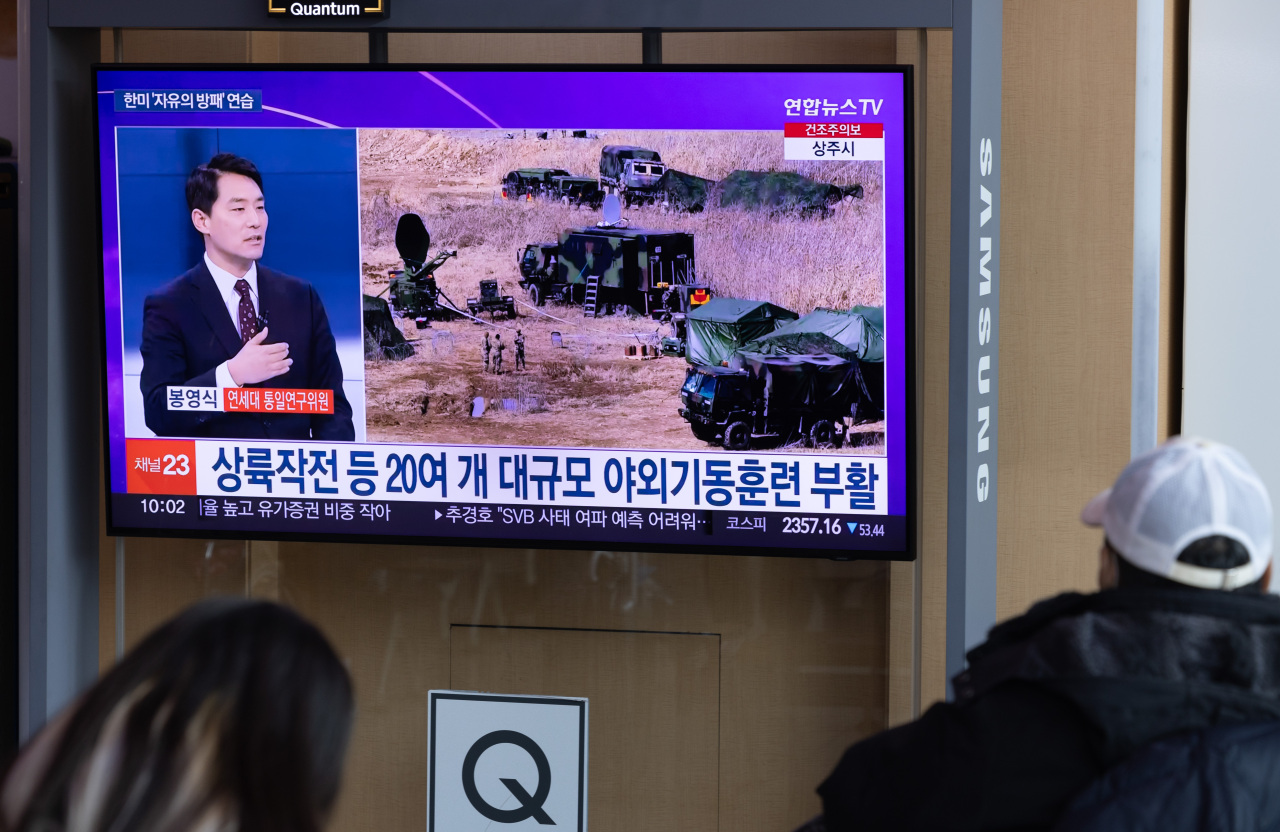 |
Passersby watch a news report on North Korean ballistic missile launches on March 14 at Seoul Station in Seoul. (Yonhap) |
The two short-range ballistic missiles were launched from the area of Jangyon County, South Hwanghae Province, from 7:41 to 7:51 a.m. local time, according to South Korea’s Joint Chiefs of Staff.
The missiles fired from the western inland area traveled around 620 kilometers before falling into the East Sea, the JCS said, adding that the South Korean and the US intelligence authorities have been comprehensively analyzing the specifications of the missiles.
Tuesday’s launches mark the first time that North Korea has fired missiles from Jangyon County, the JCS confirmed, declining to clarify if any military installations are located in the region.
“North Korea intended to heighten tensions by launching missiles from the area in the vicinity of the maritime buffer zone designated by South and North Korea in the Sept. 19 comprehensive military agreement,” Shin Jong-woo, a senior analyst at the Korea Defense and Security Forum in Seoul, told The Korea Herald.
In the military tension reduction deal, the two Koreas committed to cease all live-fire and maritime maneuver exercises within the buffer zone, which is north of the South Korean island of Deokjeokdo and south of the North Korean island of Chodo in the West Sea. Jangyon County is located south of the island of Chodo.
The travel distance also shows that North Korea can hit any target on South Korean territory with short-range ballistic missiles.
“Our military is maintaining a full readiness posture in close coordination with the US while strengthening monitoring and vigilance in preparation for additional launches,” the JCS said, suggesting that North Korea would continue their saber-rattling.
“Our military will stage combined military exercises without a hitch based on a firm combined defense posture,” the JCS said, highlighting its military capabilities to “overwhelmingly respond to any North Korean provocation.”
North Korea has consecutively fired ballistic and cruise missiles with different ranges, in an apparent tit-for-tat move to the ongoing 11-day Freedom Shield exercise between South Korea and the US that began Monday.
North Korea’s Central Military Commission has approved significant, practical steps to forcefully and offensively use war deterrence at a recent meeting convened by North Korean leader Kim Jong-un, state media reported Sunday.
The allies stage their longest-running, large-scale military exercises redesigned to strengthen defense and response capabilities against escalating threats from North Korea and enable troops to enhance their combat readiness under real war conditions.
The allies have agreed to stage around 20 field training exercises, including amphibious landing drills, in connection with the Freedom Shield springtime exercise.
In response, North Korea has vehemently lambasted South Korea and the US for reviving theater-level field training exercises that had been suspended in the aftermath of the first US-North Korea summit in Singapore in June 2018.
But US State Department spokesperson Ned Price on Monday underscored that North Korea’s belligerent acts of endangering the security environment in Northeast Asia and the surrounding Indo-Pacific region have driven the allies to step up military exercises, which are longstanding, routine and defensive in nature.
“They support the security of both the United States and, in this case, the ROK. And unfortunately, the DPRK has put us in a position to have to reinforce in tangible ways the security commitment that we have,” Price said, referring to South and North Korea by the acronyms of their official names, the Republic of Korea and the Democratic People’s Republic of Korea, respectively.
North Korea has fired various missiles, labeling the launches as live-fire drills, after Kim Yo-jong, North Korean leader Kim Jong-un’s sister and mouthpiece, warned in early March that the country would take “appropriate, swift and overwhelming actions at any time” against the allies.
North Korea fired a salvo of six close-range ballistic missiles and two submarine-launched cruise missiles respectively on March 9 and Sunday. But North Korean media described the launches as a “fire assault drill” and an “underwater live-fire drill.”
“North Korea will likely carry out various types of weapons testing and exercises to demonstrate its war deterrence and conduct war simulation drills,” said Ellen Kim, deputy director of the Korea Chair at the Center for Strategic and International Studies.
Kim also said North Korea could launch an intercontinental ballistic missile at a normal angle, citing Kim Yo-jong’s threat to turn the Pacific into its “firing range,” among other reasons.
Yang Moo-jin, a professor at the University of North Korean Studies in Seoul, said North Korea would decide whether to intensify military pressure and launch intermediate-range ICBMs depending on how the Freedom Shield exercise unfolds.







![[Today’s K-pop] Blackpink’s Jennie, Lisa invited to Coachella as solo acts](http://res.heraldm.com/phpwas/restmb_idxmake.php?idx=644&simg=/content/image/2024/11/21/20241121050099_0.jpg)